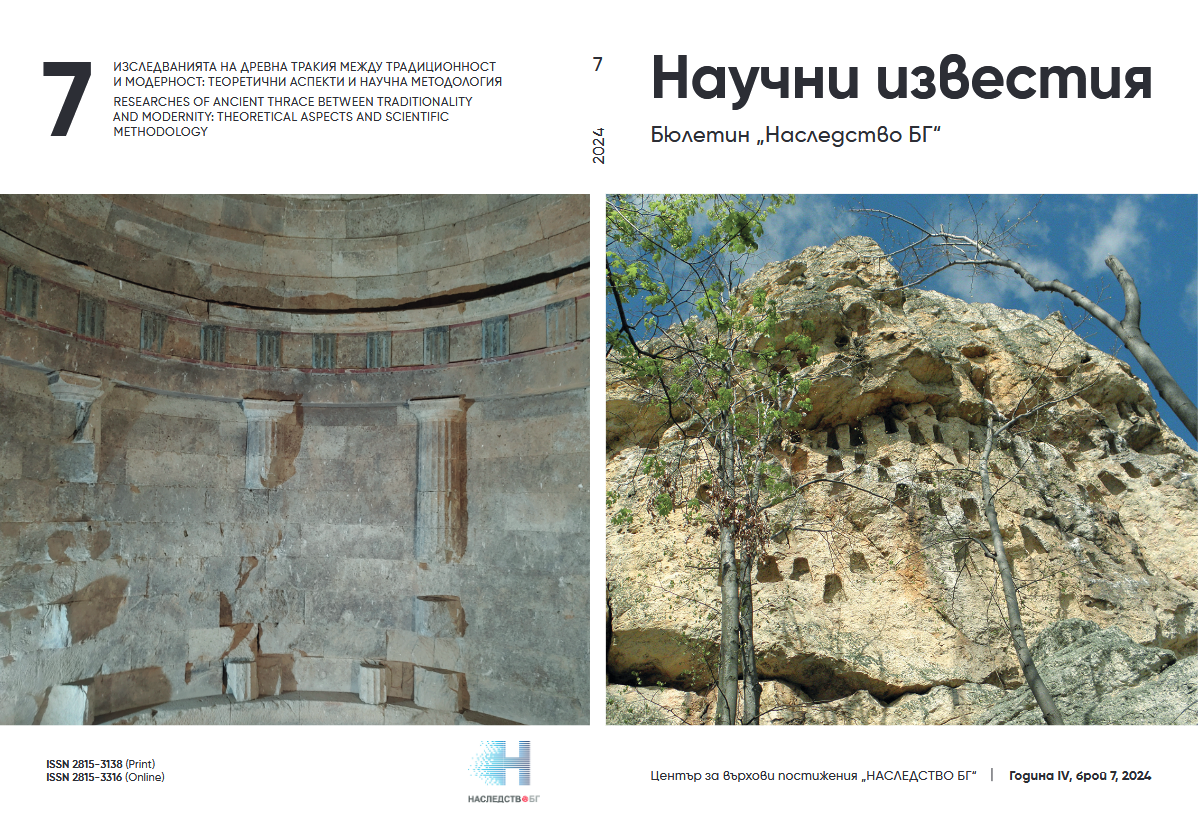Intervisibility among the thousand mounds of the Yambol province
Keywords:
visibility, landscape archaeology, burial mounds in Yambol ProvinceAbstract
Visibility and intervisibility have always been important aspects ofspatial analysis in landscape archaeological studies but remain hampered by poor inputs such as small-scale study area, edge effects, and bare-earth models. This paper assesses intervisibility in a dataset of ~1000 burial mounds in the Middle Tundzha River watershed addressing these very issues via a regional analysis of several vegetation simulating terrain models that include mounds beyond the region to nullify edge effects.
References:
ASTER Global Digital Elevation Model. n.d. ASTER GDEM. (Accessed 25.06.2024). https://gdemdl.aster.jspacesystems.or.jp/index_en.html.
Bakardzhiev, S. (2005). Spasitelni archeologicheski prouchvannia na mogilen nekropol v m. Subev bair pri s. Drazhevo, obshtina Tundzha. – Arheologicheski otkritia i razkopki prez 2004 g. Sofia, 150-153.
Buikstra, J., & Charles, D. (1999). Centering the Ancestors. In: Archaeologies of Landscape: Contemporary Perspectives (eds. Wendy Ashmore and Arthur Bernard Knapp). Oxford: Blackwell, 201-228.
Connor, S., et al. (2018). Environmental Conditions in the SE Balkans since the Last Glacial Maximum and Their Influence on the Spread of Agriculture into Europe. – Quaternary Science Reviews, No. 68, 200-215.
Criado, F. (2013). The Visibility of the Archaeological Record and the Interpretation of Social Reality. In: Interpreting Archaeology (ed. Ian Hodder). London: Routledge, 194-204.
Čučković, Z. (2023). Visibility Networks. In: The Oxford Handbook of Archaeological Network Research (eds. Tom Brughmans, Barbara J. Mills, Jessica Munson, Matthew A. Peeples). Oxford: Oxford University Press, 230-247.
Fraser, D. (1983). Land and Society in Neolithic Orkney. B.A.R.
Gaffney, V., & Stančič, Z. (1991). GIS Approaches to Regional Analysis: A Case Study of the Island of Hvar. David Brown Book Co.
Higuchi, T. (1988). Visual and Spatial Structure of Landscapes. MIT Press.
Hodder, I. (1986). Reading the Past. Cambridge University Press.
Lake, M., & Ortega, D. (2013). Compute-Intensive GIS Visibility Analysis of the Settings of Prehistoric Stone Circles. In: Computational Approaches to Archaeological Spaces (eds. Andrew Bevan, Mark Lake). Left Coast Press, 213-242.
Lake, M., & Woodman, P. (2003). Visibility Studies in Archaeology: A Review and Case Study. – Environment and Planning. B, Planning & Design, No. 30/5, 689-707.
Llobera, M. (2001). Building Past Landscape Perception with GIS; Understanding Topographic Prominence. – Journal of Archaeological Science, No. 28/9, 1005-1014.
Llobera, M. (2003). Extending GIS-Based Visual Analysis: The Concept of Visualscapes. – International Journal of Geographical Information Science: IJGIS, No. 17/1, 25-48.
Llobera, M., et al. (2010). Calculating the Inherent Visual Structure of a Landscape (‘total Viewshed’) Using High-Throughput Computing. In: Beyond the Artefact: Digital Interpretation of the Past. Proceedings of CAA2004 Prato, 13-17 April 2004. (eds. Franco Niccolucci, Sorin Hermon). Budapest: Archaeolingua, 1-8.
Madry, S., & Rakos, L. (1996). Line-of-Sight and Cost-Surface Techniques for Regional Research in the Arroux River Valley. In: New Methods, Old Problems: Geographic Information Systems in Modern Archaeological Research. (ed. Herbert D.G.Maschner). Carbondale, 104-26.
Penske, S., et al. (2023). Early Contact between Late Farming and Pastoralist Societies in Southeastern Europe. – Nature, No. 620/7973, 358-365.
Privat, K., et al. (2018). Excavation and Palaeodietary Analysis of Bronze Age Human Remains from Boyanovo, Yambol Province. In: The Tundzha Regional Archaeological Project: Surface Survey, Palaeoecology, and Associated Studies in Central and Southeast Bulgaria, 2009 – 2015 Final Report. (eds. Shawn Adrian Ross, Adela Sobotkova, Julia Tzvetkova, Georgi Nekhrizov, Simon Connor). Oxford, 182-190.
Ross, S., et al. (2010). An Interdisciplinary Pilot Project in the Environs of Kabyle, Bulgaria. – Archaeologia Bulgarica, No. 14/2, 69-85.
Ross, S., et al. (2012). The Tundzha Regional Archaeological Project: Elhovo 2009 Preliminary Report. Historical Museum Yambol.
Ross, S., et al. (2018). The Tundzha Regional Archaeological Project: Surface Survey, Palaeoecology, and Associated Studies in Central and Southeast Bulgaria, 2009 – 2015 Final Report. Oxford: Oxbow Books, Limited.
Shanks, M., & Hodder, I. (1995). Processual, Postprocessual and Interpretive Archaeologies. In: Interpreting Archaeology: Finding meaning in the Past (eds. Ian Hodder, Michael Shanks, Alexandra Alexandri, Victor Buchli, John Carman, Jonathan Last, Gavin Lucas). London: Routledge, 3-33.
Skov-Petersen, H., & Snizek, B. (2007). To See or Not to See: Assessment of Probabilistic Visibility. In: Agile 2007. 10th AGILE International Conference on Geographic Information Science. Aalborg University Press, 1-12.
Sobotkova, A., et al. (2023). Creating Large, High-Quality Geospatial Datasets from Historical Maps Using Novice Volunteers. – Applied Geography 155 (June): 102967. https://doi.org/10.1016/j.apgeog.2023.102967.
Sobotkova, A., & Weissova, B. (2019). Locational Analysis of Burial Mounds in the Middle Tundzha River Watershed. Combining Historical Maps with Field Survey and Satellite Image Analysis Data. In: Studia in Honorem Iliae Iliev. (ed. Todor Vulchev). Yambol, 6/9, 161-175.
Sobotkova, A., & Weissova, B. (2020). Soviet Topographic Maps and Burial Mounds of the Yambol Province: Digital Workflow for Mortuary Landscape Verification. – Archaeological Prospection, No. 27 (February), 253-262. https://doi.org/10.1002/arp.1769.
Tilley, C. (1994). A Phenomenology of Landscape: Places, Paths and Monuments, December.
Van Leusen, M. (1999). Line of Sight and Cost SurfaceAnalysis Using GIS. In: Pattern to Process (ed. Martijn Van Leusen). Oxford: Archaeopress, 1-23.
Verhagen, P. (2018). Spatial Analysis in Archaeology: Moving into New Territories. In: Digital Geoarchaeology: New Techniques for Interdisciplinary Human-Environmental Research (eds. Christoph Siart, Markus Forbriger, Olaf Bubenzer). Cham, 11-25.
Wheatley, D. (1995). Cumulative Viewshed Analysis: A GIS-Based Method for Investigating Intervisibility, and Its Archaeological Application. In: Archaeology and Geographical Information Systems: A European Perspective (eds. Gary R. Lock, Zoran Stančič). London: Routledge, 5-13.
Wheatley, D., & Gillings, M. (2000). Vision, Perception and GIS: Developing Enriched Approaches to the Study of Archaeological Visibility. In: Beyond the Map: Archaeology and Spatial Technologies (ed. Gary R. Lock). Volume 321 of NATO Science Series. Ohmsha: IOS Press, 1-27.
Williams, H. (1999). Placing the Dead: Investigating the Location of Wealthy Barrow Burials in Seventh Century England. In: Eight Studies of First Millennium AD Burials in Crimea, England and Southern Scandinavia: Papers from a Session Held at the European Association of Archaeologists Fourth Annual Meeting in Göteborg 1998 (ed. Martin Rundkvist). Archaeopress, 57-81.

